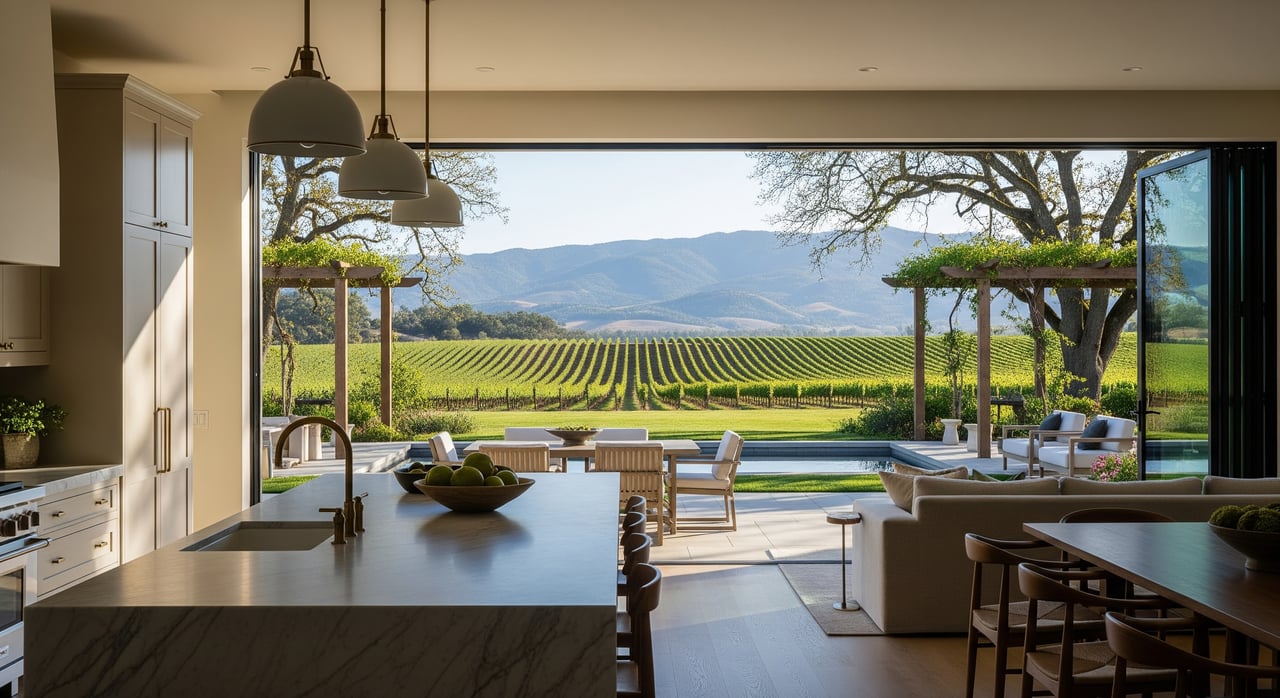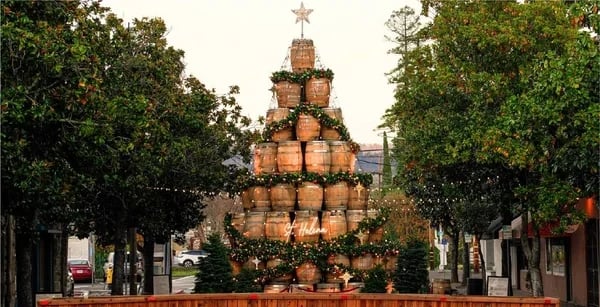FIND IT FAST
As of mid-July 2025, the housing market is experiencing a period of relatively high mortgage rates compared to the record lows seen during the pandemic. However, rates have generally stabilized and even seen slight decreases in recent weeks, though significant drops aren't currently anticipated.
For luxury wine country buyers, this "new normal" presents both challenges and unique opportunities that require a sophisticated approach to financing and market timing.
Here's a breakdown of the current situation and key factors at play:
Current Rate Snapshot
-
30-year fixed-rate mortgage: The national average hovers around 6.7% to 6.9%, with some reports showing slight increases or decreases on a daily or weekly basis.
-
15-year fixed-rate mortgage: These rates are generally lower than 30-year fixed mortgages, averaging around 5.9% to 6.0%.
-
Adjustable-rate mortgages (ARMs): Rates on ARMs can fluctuate, but generally follow similar trends to fixed-rate mortgages, potentially starting lower before adjusting based on market conditions.
For wine country luxury properties, these rates translate to significantly different monthly payments compared to the 2.5-3% rates we saw just a few years ago.
Key Market Influencing Factors
Federal Reserve Policy
The Fed's decisions regarding the federal funds rate and its balance sheet management have an indirect impact on mortgage rates. While the Fed implemented rate cuts in late 2024, it has maintained a "wait-and-see" approach for much of 2025, according to Norada Real Estate Investments.
Economic Indicators Affecting Wine Country Markets
-
Inflation: Inflationary pressures directly impact lending costs, potentially leading to higher mortgage rates.
-
Economic Growth and Job Market: A strong economy and healthy job market can increase consumer confidence and borrowing, which can also influence rates.
-
10-year Treasury Yield: This benchmark is closely tied to mortgage rates, and its fluctuations can signal potential shifts in the mortgage market.
-
Market Demand: The balance between housing inventory and buyer demand influences how aggressively lenders compete for business, ultimately affecting rates.
Want the latest marketing data on Wine Country Real Estate
I share monthly updates from the most popular cities/counties across the Napa Valley.
3 Strategic Approaches for Wine Country Luxury Buyers
1. Embrace the Premium Financing Mindset
Wine country luxury buyers often have access to specialized loan products that the average homebuyer doesn't. Consider these financing strategies:
-
Jumbo Loan Optimization: Most wine country luxury properties exceed conventional loan limits, requiring jumbo financing. Work with lenders who specialize in high-end properties and understand the unique aspects of valuing vineyards and estates.
-
Portfolio Lending: Private banks and wealth management firms often offer portfolio loans with more flexible terms for high-net-worth individuals. These loans aren't sold to government-sponsored enterprises, allowing for more creative structuring.
-
Asset-Based Lending: For buyers with significant liquid assets but complex income structures (common among entrepreneurs and investors), asset-based lending can provide attractive alternatives to traditional income verification.
2. Consider Alternative Financing Structures
-
Interest-Only Loans: For luxury buyers who prefer to preserve cash flow for other investments, interest-only loans can be desirable in wine country, where property appreciation has historically been strong.
-
ARM Strategies: Given the current rate environment, a 7/1 or 10/1 ARM might offer initial savings for buyers who plan to refinance or sell within the adjustment period.
-
Bridge Financing: Many wine country buyers are simultaneously selling and purchasing. Bridge loans can provide the flexibility to secure your dream property without the constraints of timing.
3. Timing Your Wine Country Purchase
-
Seasonal Market Advantages: Wine country has unique seasonal patterns. Late summer and early fall, during the harvest season, can be optimal times to purchase, as the region's beauty is at its fullest display, but competition may be lighter than in spring markets.
-
Rate Lock Strategies: Given current volatility, consider more extended rate lock periods (60-90 days) to protect against potential increases during the typically more extended escrow periods associated with luxury properties.
Wine Country-Specific Considerations
Property Valuation Complexities
Wine country properties often include:
-
Vineyard operations with income-producing potential
-
Custom wineries and production facilities
-
Agricultural land with different zoning considerations
-
Water rights and sound systems
-
Unique architectural features requiring specialized appraisals
These factors can complicate traditional mortgage underwriting. Work with lenders who are experienced in financing agricultural and luxury properties.
Insurance and Risk Management
Wine country properties face unique risks (wildfire, earthquake, flood) that affect both insurance costs and lending requirements. Factor these into your total cost of ownership calculations.
Tax Implications
Many wine country properties qualify for agricultural tax benefits. Understanding these implications can affect your financing strategy and overall investment return.
Need guidance in selling or purchasing your piece of Wine Country?
Predictions & Market Outlook
Overall Stability
Most experts anticipate that mortgage rates will remain relatively stable, hovering between 6.5% and 6.8% for the remainder of July and into September.
Potential for Gradual Improvement
Some forecasts suggest rates may gradually decline towards the latter half of 2025, but significant drops below the 6% mark are not widely expected in the near term.
Uncertainty Factors
Elements such as inflation, potential tariffs, and upcoming Federal Reserve meetings can create volatility, making precise rate predictions challenging.
Actionable Strategies for Wine Country Buyers
1. Focus on Total Cost of Ownership
Rather than fixating solely on interest rates, consider:
-
Property taxes (often lower in agricultural areas)
-
Maintenance costs for luxury amenities
-
Potential rental income from vineyard operations
-
Long-term appreciation potential
2. Build Relationships with Specialized Lenders
Not all lenders are familiar with wine country properties. Establish relationships with:
-
Agricultural lending specialists
-
Private banks with luxury property experience
-
Local credit unions are familiar with the region
-
Portfolio lenders who keep loans in-house
3. Prepare for Longer Timelines
Luxury wine country transactions often take longer due to:
-
Complex property inspections
-
Specialized appraisals
-
Agricultural permitting issues
-
Custom loan structuring
4. Consider the Investment Perspective
Wine country luxury properties often offer:
-
Lifestyle benefits that justify premium pricing
-
Potential income streams from vineyard operations or event hosting
-
Strong appreciation of history in established wine regions
-
Portfolio diversification benefits
My Luxury Real Estate Agent Recommendations
For First-Time Wine Country Buyers
-
Get pre-approved early with multiple lenders to understand your options
-
Factor in all costs, including vineyard maintenance, water rights, and seasonal labor
-
Consider starting smaller in established wine regions before moving to luxury estates
-
Work with experienced local agents who understand agricultural property nuances
For Luxury Property Investors
-
Explore portfolio lending options that offer better terms for high-net-worth individuals.
-
Consider 1031 exchanges if moving from other investment properties
-
Evaluate the income-producing potential of vineyard operations
-
Plan for seasonal cash flow variations in agricultural operations
For Relocating Executives
-
Investigate corporate relocation programs that offer financing assistance
-
Consider bridge financing to avoid timing pressures
-
Evaluate lifestyle costs beyond mortgage payments
-
Plan for potential remote work infrastructure needs
The Bottom Line: Opportunity in the New Normal
While mortgage rates remain elevated compared to recent historical lows, wine country luxury real estate continues to offer compelling opportunities for discerning buyers. The current market environment favors serious buyers who can act decisively and understand the unique aspects of owning a wine country property.
Key Takeaways:
-
Rates between 6.5 and 6.8% represent the current reality, not a temporary spike.
-
Luxury buyers have access to specialized financing options that are not available to typical homebuyers.
-
Wine country properties offer unique value propositions that can justify premium financing costs.
-
Working with experienced professionals who are familiar with both agricultural and luxury properties is essential.
Rather than attempting to time the market for significantly lower rates, focus on finding the right property and structuring financing that aligns with your long-term investment and lifestyle goals. In wine country's luxury market, the right property at the right price often matters more than saving a quarter-point on interest rates.
The perfect wine country estate, like a great vintage, is worth waiting for—but when you find it, be prepared to act with confidence and the right financing strategy.
For personalized guidance on wine country luxury real estate financing strategies, consult with mortgage professionals who specialize in high-end agricultural and luxury properties. Market conditions and individual circumstances vary, making professional advice essential for optimal outcomes.




